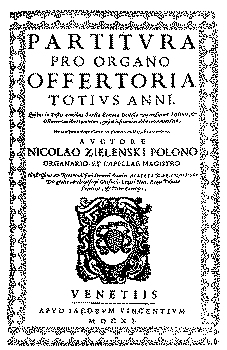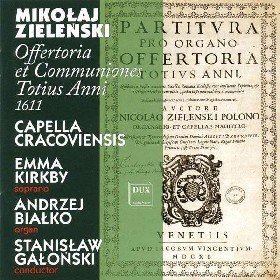Zielinski, Mikolai - Ave Maria
 for 8vv and organ
for 8vv and organ
 | Composer: Mikolai Zielinski (s.a.) Aliases, aka: Country of origin / activity: Poland | |
| Text author: traditional | ||
| Arranger / Editor: N/A |
Similar names or titles
| MIDI | MP3 | VID | First name | Last name | Birth | Death | comp | ID # | Title | Voicing | Instrumentation | |
|---|---|---|---|---|---|---|---|---|---|---|---|---|
| 1 | 1 | 0 | 0 | Michal | Zielenski | 1965 | 2002 | Ave Maria | SATB | a cappella | ||
| 0 | 0 | 1 | 1 | Mikolai | Zielenski | 1550 | 1615 | 1611 | Ave Maria | 8vv | organ |
Available documentation:
Score:| not available | |
 | |
| My thanks and appreciation to ... for sending me this score. | |
Lyrics: (source)
| not available |
| MIDI: not available | MP3: not available |
| Recording: |
 | CD: |
Video - posted on YouTube:
Internet references, biography information:
| http://en.wikipedia.org/wiki/Mikołaj_Zieleński |
From Wikipedia, the free encyclopedia Zieleński's only known surviving works are two 1611 liturgical cycles of polychoral works, the Offertoria/Communes totius anni. These were dedicated to the Archbishop of Gniezno, Wojciech Baranowski. The whole comprises eight part-books and a ninth book, the Partitura pro organo, which constitutes the organ accompaniment. This publication contains in all 131 pieces written for various vocal and also vocal and instrumental ensembles, all with organ accompaniment. The Venetian publication does not only comprise the offertories and communions; we find there also over a dozen other pieces, such as hymns, antiphons, a magnificat, and even three instrumental fantasias. In his compositions Zieleński relies on his own creative invention and does not, in general, make use of the cantus firmi. The few pieces which a pre-existent melody may be traced out are based not on a plainsong melody but on the melodies of Polish songs. The sets consist of large-scale double- and triple-choir antiphons, as well as some monodic works typical of the Seconda pratica style of early Monteverdi. Zieleński's music is the first known Polish music set in the style of the Baroque. Works |
http://completorium.republika.pl/c_zielen.htm |
Following note comes from CD record with Zieleński's music. I could not find it's author, otherwise I would mention his/her name there. "Little is known today about the life and work of Mikołaj Zieleński, who lived in the turn of the 17th century, indeed too little, considering the volume of his work and its historical significance. The fragmentary information we have about him today allows us to reconstruct but a very fragmentary biographical sketch about this composer. The circumstances in which his exceptional talent was born are a matter of many hypotheses and conjectures. The music created thanks to his exceptional gift allowed Zieleński to take a place in the history of music whereby he is even regarded as the best Polish composer before Chopin. Szymon Skorowolski, a historian contemporary to Zieleński, classified him as a member of a group of Polish composers who had been educated in Rome: in media Roma exercitati. This is a reference of great significance as it locates the fundamental source of his musical knowledge as a professional composer. All the above suppositions and conclusions seem to find corroboration in the two volumes of works by Mikołaj Zieleński, the Offertoria and the Communiones published in Venice in 1611 at the printing press of Jacob Vincentius. Both the frontispiece and the short preface published in this book state that Zieleński was a composer, organist and Kapelmeister at the court of the Polish primate Wojciech Baranowski. The status of the patron as well as the seat of his court, Łowicz, the capital of the archbishops and primates of Poland, and a well-known centre of musical life, were fully in keeping with the composer's rank as a musician. Unfortunately, these are the only known facts concerning the life and work of Mikołaj Zieleński. We know much more about his mastery as a composer from the works he managed to publish. Offertoria totius anni which make up the first volume, contain 56 seven - and eight voice compositions enriched with the accompaniment of instruments. Next to the Offertoria known surely after Gabrielli's Sacrae Simphoniae we find here a twelve voice Magnificat. The pieces in this collection are rendered in the concert style of the polychoral Venetian school. Let us emphasize that the eight voice texture became the most typical form of this type of composition at the beginning of the 17th century. By taking up this trend, Zieleński became one of the precursors of the innovational approach to the offertory. Communiones totius anni is composed of 57 (63? - A.J.) pieces differing as to the number of voices (from one to six) and as to the cast of performers. The majority among them are concertante motets transposed in nota contra notam and often alluding to the classical style of Palestrina. A considerable group of pieces consists of tercets, duets and accompanied monodies. The application of the monodic and concertante styles in the Communiones testifies to the innovational character of Mikołaj Zieleński |
http://www.usc.edu/dept/polish_music/composer/zielenski.html |
Mikołaj Zieleński was a bandmaster and organist at the court of the primate Wojciech Baranowski in Lowicz. It is not known since when and for how long he was in this position. Also unknown are the dates of his birth and death. (However, Wojciech Baranowski was a primate from 1608 until 1615). Some suggested that Zieleński studied in Venice but there is no proof of that even though his works were published there. Zieleński's preserved compositions are as follows: Offertoria totius anni and Communiones totius anni, together 122 works which were published by Vincentius in Venice in 1611. The collection of Offertoria is made up of 56 compositions. The first 44 works are based on liturgical text of offertoria. The text of the others consist of two communions, one magnificat, and nine different religious texts. Except for the Magnificat which is for 12 voices (3 choirs for 4 voices) all the other compositions are for 8 or 7 voices( 2 choirs for 4 voices, 1 choir for 4 voices, and 1 choir for 4 voices and 3 voices). |
 avemariasongs
avemariasongs org
org